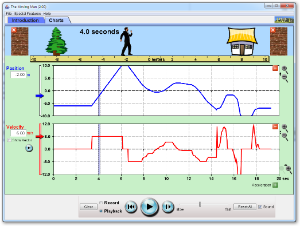| << Chapter < Page | Chapter >> Page > |


This simulation allows you the opportunity to plot graphs of motion and to see how the graphs of motion change when you move the man.

In this chapter we will look at the third way to describe motion. We have looked at describing motion in terms of graphs and words. In this section we examine equations that can be used to describe motion.
This section is about solving problems relating to uniformly accelerated motion. In other words, motion at constant acceleration.
The following are the variables that will be used in this section:
The questions can vary a lot, but the following method for answering them will always work. Use this when attempting a question that involves motion with constant acceleration. You need any three known quantities ( , , , or ) to be able to calculate the fourth one.
Galileo Galilei of Pisa, Italy, was the first to determined the correct mathematical law foracceleration: the total distance covered, starting from rest, is proportional to the square of the time. He also concluded thatobjects retain their velocity unless a force – often friction – acts upon them, refuting the accepted Aristotelian hypothesis thatobjects "naturally" slow down and stop unless a force acts upon them. This principle was incorporated into Newton's laws of motion(1st law).
The following does not form part of the syllabus and can be considered additional information.
According to the definition of acceleration:

Notification Switch
Would you like to follow the 'Physics - grade 10 [caps 2011]' conversation and receive update notifications?